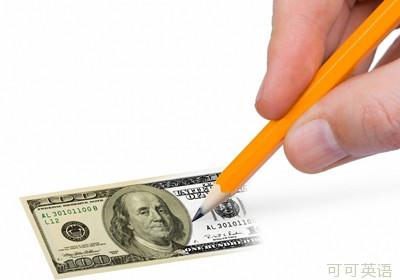(单词翻译:单击)
Money Changers ever wonder how a money changer machine knows if you've given it a one, a five or a ten dollar bill? When a bill is inserted into a money changer machine, it disrupts a light beam from within the machine.
兑钞机是如何辨别塞进去的钞票是一元、五元、还是10元?兑钞人员也曾对此感到疑惑吗?当纸币被塞进一个兑钞机时,阻挡了机器内部的光束。
This action triggers the motor to pull the bill into the money changer. The machine then begins a procedure by which it first makes sure the bill is actual currency and then determines the denomination of the bill. With a computer chip and measuring devices, the money changer checks the length, width and thickness of the bill.

这个动作触发电动机把钞票拉进机器内。然后机器开始执行一系列的程序:首先确定纸币是否真实,然后检查纸币的面额。兑钞机通过一块电脑芯片和测量设备来检测钞票的长度、宽度和厚度。
If the bill is not the exact length and thickness it should be, the changer will reject it and refuse to give you any change. The sensors that evaluate the bill are so sensitive that even an old, wrinkled bill usually will not pass this authenticity test because it will not measure precisely the same as a crisp, new bill.
如果长度和厚度不达标,兑钞机就拒绝兑换。对钞票进行估价的传感器灵敏度极高。即使是旧的、有褶皱的钞票通常也不会通过验证检测,因为这样的钞票的检测结果达不到崭新钞票的标准。
After the machine measures the bill's width, length and thickness, it optically scans the bill to determine if it is a one, five, or ten dollar bill. The machine makes this decision by “reading” how much ink is in different places on the bill.
兑钞机测量钞票的长、宽以及厚度之后,便开始扫描钞票,判断它的面值是一元、五元还是十元。机器通过“读出”钞票上不同部位的油墨含量来判断钞票的面额。
The U.S. treasury department uses specially manufactured ink that has unique magnetic properties. The machine's optical scanner measures this magnetic ink. And because a one dollar bill has a different ink pattern than a five or ten dollar bill, the computer inside the machine is able to differentiate between these denominations with a quick scan.
美国财政部门利用专门制造的油墨来印钞,这种墨水的特性是具有磁性。兑钞机内部的光扫描器能测量这种磁性油墨。因为一美元钞票上的油墨图案与五美元的不同,兑钞机内的电脑能通过快速扫描来识别不同面值的钞票。
原文译文属可可原创,未经允许请勿转载!


